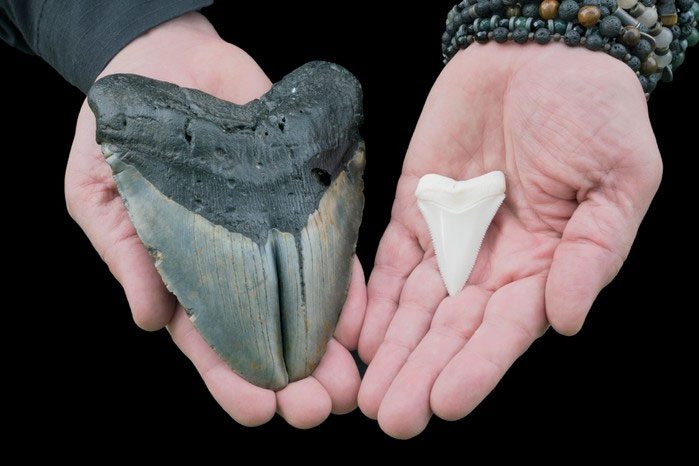The giant shark species Megalodon was once a dangerous predator of the ancient oceans, with serrated teeth measuring up to 18 cm capable of tearing apart any prey beneath the sea.
Recently, scientists have discovered evidence from dental enamel confirming that Megalodon was a warm-blooded species—a characteristic that may have contributed to its extinction.

Megalodon is believed to be a warm-blooded species. (Source: New Scientist).
Researchers found answers by analyzing the fossilized teeth of this ancient shark.
The analysis results helped determine the temperature at which the minerals similar to those in dental enamel were formed. The composition of the fossilized teeth can provide additional information about the habitat and diet of Megalodon.
Researchers estimate that a Megalodon could have been between 15 to 20 meters long, with an average body temperature of around 27 degrees Celsius, maintained at about 7 degrees Celsius higher than the surrounding seawater.
This seems to have helped Megalodon become a powerful predator, capable of digesting food efficiently and importantly, tolerating cold water environments, allowing them to expand their range to nearly all oceans around the world.
Most fish species are cold-blooded, with body temperatures that align with the surrounding water temperature.
Only a few species are warm-blooded, capable of generating the heat their bodies need, such as the great white shark.
The lead author of the study, geochemist Michael Griffiths from William Paterson University in New Jersey (USA), noted that modern fish comparable to Megalodon in terms of diet and body temperature include the great white shark and the mako shark.
However, Megalodon’s body temperature is higher than both of these species but lower than that of whales.
Megalodon may be the largest shark of all time, appearing around 23 million years ago and disappearing about 3.6 million years ago due to decreasing ocean temperatures and sea levels.

Comparison of Megalodon teeth and great white shark teeth. (Photo: Getty)
With warm-blooded characteristics, Megalodon may have adapted more easily to cooler water conditions.
However, co-author of the study, archaeologist Kenshu Shimada from DePaul University in Chicago (USA), noted that the reason for this species’ extinction could be precisely due to its warm-blooded nature, which required them to consume large quantities of food to maintain a high metabolic rate.
The cooler climate disrupted marine ecosystems, leading to decreased sea levels and altering the habitats of the primary food sources for Megalodon, making them scarce and resulting in the shark’s extinction.
According to author Shimada, Megalodon is primarily known through its teeth and some fossilized vertebrae.
In movies and novels, Megalodon is depicted as a giant shark, but in reality, scientists have yet to determine its exact shape. This is why research on Megalodon remains an intriguing field.


















































